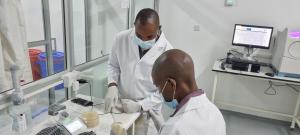High level of resistant bacteria circulating in the environment, food chain and community: A call to strengthen One Health Surveillance on antimicrobial resistance in Zimbabwe
By Tatenda Chimbwanda
Kadoma, Zimbabwe - Antimicrobial resistance (AMR) is a threat to global public health, which involves the human, animal, food, plants, and environment sectors. AMR happens when germs like bacteria and fungi develop the ability to defeat the drugs designed to kill them. As a result, the medicines become ineffective, and infections can persist in the body and/or spread to others. This increases illness and even deaths in humans, animals, and plants. It also has implications for food safety, food security and the economic well-being of millions of people.
In 2017, Zimbabwe established a One Health AMR surveillance system through which AMR studies were done to understand the characteristics of bacteria which caused cholera and typhoid outbreaks in the recent past. However, a robust multisectoral surveillance system is needed to generate reliable data to assess the magnitude of AMR in Zimbabwe.
To strengthen Zimbabwe’s One Health AMR surveillance, the country implemented the WHO Extended Spectrum Beta-Lactamase Escherichia coli (ESBL Ec) Tricycle [1] protocol. The Tricycle protocol detects and estimates, the proportion of highly drug resistant bacteria, (ESBL Ec) in three key sectors, namely: humans (hospital and community); the food chain (animals); and the environment.
The implementation of the WHO Tricycle was between March 2021 to March 2022 and was done under the National AMR Action Plan (2017 - 2022), Research Strategic Objective. A series of activities were conducted which includes sensitisation and protocol adoption, distribution of reagents, sampling, isolation, and screening for ESBL Ec, full antibiotic profiling and data analysis using local and international trainers. Repeated annually, this protocol will provide a common set of metrics to follow over time and increase capacities for expansion at the national level while including other foodborne pathogens. This will strengthen Zimbabwe’s national integrated surveillance systems for AMR.
“As the Government of Zimbabwe (GoZ), we take AMR seriously and it has the highest level of commitment and support from the presidium. We have done this by supporting the three different ministries (health, lands, and environment) that are involved. Results from this study are going to inform our future AMR interventions,” noted, Ministry of Health and Child Care (MoHCC), Chief Director of Public Health (AMR Focal Point), Dr Munyaradzi Dobbie. “The GoZ is now being proactive in addressing AMR and no longer waiting for outbreaks to happen to find out which antibiotics are no longer working,” he added.
“A multi-sector approach to contain AMR includes a coordinated approach to the collection and analysis of AMR data across key sectors to inform decision making and containment activities. The Tricycle protocol provides a genuine effort towards the application of the One Health approach and a foundation for establishing a national integrated surveillance system for AMR,” says Lusubilo Mwamakamba, WHO AFRO Food Safety Focal Point.
As a result of the Tricycle protocol for global surveillance, Zimbabwe successfully managed to break down silos across the administrations namely, the MoHCC, the Ministry of Environment, Climate, Tourism and Hospitality Industry and the Ministry of Lands, Agriculture, Fisheries, Water and Rural Development. In recognition of the relationship between human, animal, plant, and environment sectors, the three ministries adopted the “One Health approach” with the aim of eliminating AMR.
“ESBL Ec Tricycle model brings the opportunity for countries to build the National Integrated Surveillance on AMR in a feasible, simple and stepwise approach”, says Jorge Matheu WHO, HQ, Team Lead, Impact Initiatives and Research Coordination Unit.
In addition, preliminary results from the study reviewed high levels of multidrug resistant bacteria circulating in Zimbabwe like the highly drug resistant bacteria ESBL Ec was found in nearly two thirds of the cecal from processed poultry samples. In humans, the same bacteria were found in more than a quarter (27%) of rectal swabs of pregnant women presenting in labour. These results are very concerning and underscore the importance of this initiative.
Results from the study will strengthen GoZ’s understanding of the magnitude of AMR in the country and monitor prevalence and changes in AMR over the years. They will also inform the development of future AMR containment strategies. The surveillance activities will enable Zimbabwe to gather more evidence on appropriate treatment for the relevant microbes. This will improve the advice disseminated to health care professionals on the safe and appropriate use of antibiotics by providing the antimicrobial profile of pathogens known to cause a given type of infection.
“This will also influence future policymaking by enabling regular updates of the essential drugs list and removal of antimicrobials that are now deemed to be ineffective”, says Dr Stanley Midzi, WHO Health Systems Strengthening & Policies Advisor.
“Surveillance remains important in helping us monitor and evaluate emerging patterns and trends of AMR in Zimbabwe. Surveillance is crucial because it contributes to better prevention and management of AMR,” noted Dr Tapfumanei Mashe, AMR Project Coordinator.
Thanks to WHO HQ and AFRO, through the Fleming Fund generous funding from the UK government, WHO Zimbabwe managed to support the GoZ to implement the WHO Tricycle protocol for the global surveillance project.
“The UK is committed to working with Zimbabwe to help tackle global issues. Antimicrobial resistance is one of the world’s greatest public threats. It kills hundreds of thousands of people across the world every year. Preliminary results from this study show that there are high levels of multi-drug resistant bacteria circulating in Zimbabwe,” noted, Department for International Development (DFID) Development Director for Zimbabwe, Geraldine O’Callaghan.
“We use science and evidence to address global health threats. Our partnership on this AMR surveillance project with the Zimbabwe government, through WHO and the Fleming Fund, will help build up the body of data on AMR resistance in Zimbabwe and contribute to the determining of appropriate policy on antibiotic drug use in Zimbabwe going forward,” added Geraldine O’Callaghan.
[1] https://www.who.int/publications/i/item/who-integrated-global-surveilla…




